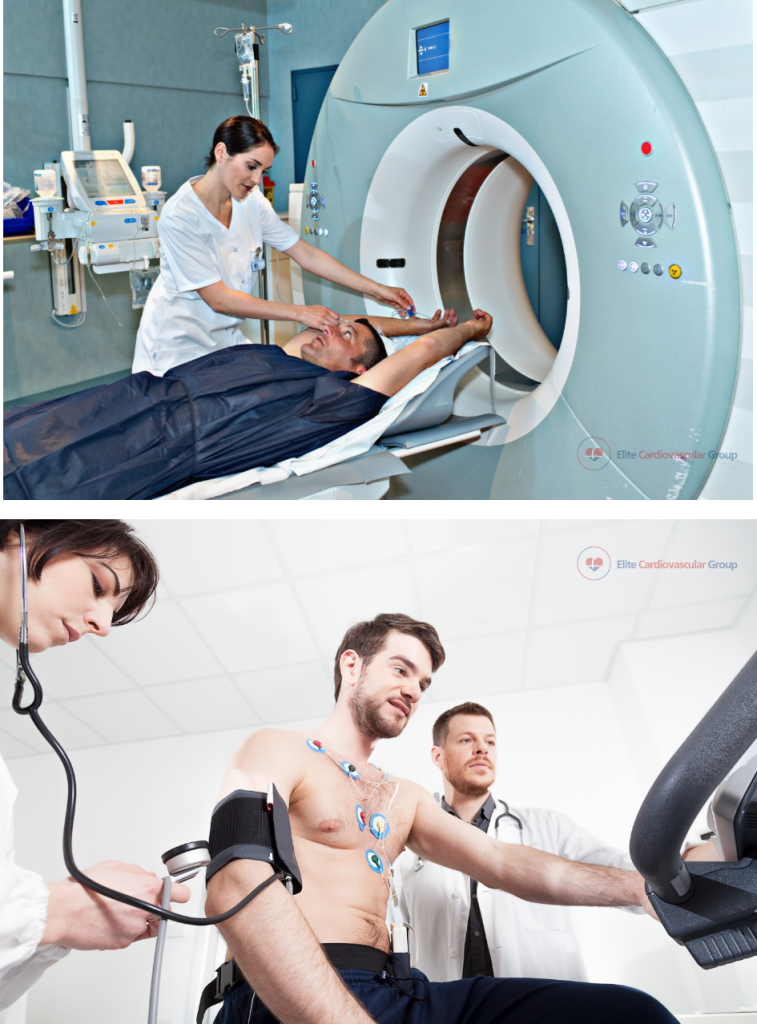Also known as: myocardial perfusion test, thallium stress test, sestamibi stress test, MIBI stress test
Duration: About 4 to 6 hours (depending on the individual)
The nuclear stress test is a diagnostic test that shows how well the blood is flowing to your heart at rest and during activity. It is a combination of an exercise stress test with radioactive dyes and imaging.

Types:
- Nuclear Exercise Stress Test
- Nuclear IV Stress Test
- Adenosine
- Dobutamine
Uses:
- To study the blood flow to your heart
- To see how well the heart is pumping
- To check for blocked arteries (ex: coronary artery disease)
- To help decide on the proper treatment plan for various heart diseases
Preparing for the test:
![]() Download Pre & Post Test Instructions
Download Pre & Post Test Instructions
How the test is performed:
Nuclear Stress Test – can be divided into a couple of parts
Part 1
- First, an IV line is set up and a small amount of radioactive tracer (thallium or sestamibi) is infused.
- After about 20 to 40 minutes, the first round of images is captured with a gamma camera since it can detect the tracer.
- Keep in mind to be as still as possible in order to get clear images.
- You may bring something to eat or drink after the test.
Part 2
- Small, sticky electrode patches are placed on your chest and are connected to the EKG machine by lead wires. Your heart rate and vitals are monitored throughout the test.
- You will then be asked to walk on a treadmill or ride a stationary bicycle.
Or
For those who cannot tolerate exercise, an IV infusion of Adenosine (a vasodilator used to “stress” the heart) or dobutamine is given to increase the blood flow to your heart imitating the effects of physical activity. - When your heart rate is high enough, a radioactive tracer (thallium or sestamibi) is infused.
- After about 20 to 40 minutes, the second round of images is captured with a gamma camera.
- Again, you must remain as still as possible in order to get clear images.
- Once finished, your doctor will discuss the results with you.
- You may eat a snack or have something to drink after the test is finished.
Note: Dobutamine is not currently used in our clinic.
Show references
Gopal S, Murphy C. Nuclear Medicine Stress Test. [Updated 2020 May 3]. In: StatPearls [Internet]. Treasure Island (FL): StatPearls Publishing; 2020 Jan-. Available from: https://www.ncbi.nlm.nih.gov/books/NBK557682/
Arbab-Zadeh A. Stress testing and non-invasive coronary angiography in patients with suspected coronary artery disease: time for a new paradigm. Heart Int. 2012;7(1):e2. doi:10.4081/hi.2012.e2
Addison D, Singh V, Okyere-Asante K, Okafor H. Cardiovascular outcomes of a positive nuclear stress test but negative coronary angiography in a multiethnic male predominant cohort. Niger Med J. 2014;55(1):14-19. doi:10.4103/0300-1652.128151
Fathala A. Myocardial perfusion scintigraphy: techniques, interpretation, indications and reporting. Ann Saudi Med. 2011;31(6):625-634. doi:10.4103/0256-4947.87101
